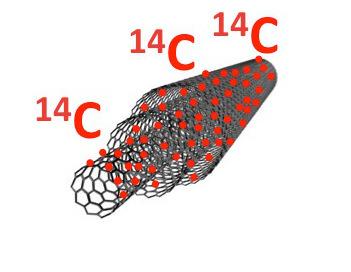Thanks to their remarkable mechanical and
electronic properties, carbon nanotubes have quickly shed their status
as a laboratory curiosity, finding applications in areas ranging from
structural materials to electronic components. This justifies the
current studies on their impacts on health and the environment.

How are these particles distributed in the body after pulmonary exposure? To
find out, researchers from the CEA (IBITECS and IRAMIS) had to develop a new
method to label them. During synthesis of the nanotubes (which are fully
comparable to industrial ones), some of their atoms were replaced by 14C atoms,
the radioactive isotope of carbon. Consequently, it became possible to track
them in the body by conventional radioimaging, as well as by electron
microscopy1 following tissue extraction. By utilizing a very good radiolabeling,
this ultrasensitive method can detect amounts as low as approximately twenty
nanotubes in an organ section.
Rodent models received a sole lung exposure of 20 micrograms of the labeled
nanotubes. This procedure aimed to reproduce an accidental inhalation, the most
likely type of contamination for humans, in particular during synthesis of
nanotubes or the manufacture of objects containing them. The rodents were then
examined at regular intervals for one year. This study demonstrates that a small
fraction (0.7%) of nanotubes are able to cross the pulmonary barrier
(i.e. the air/blood barrier), which are then steered especially to the
liver, spleen and bone marrow. The continued increase in the amount of nanotubes
found in these organs reflects an absence of elimination, at least during the
twelve months that follow. Although these results are not directly transposable
to humans, they do emphasize the importance of ultrasensitive detection methods
for assessing the behavior of nanoparticles in the animal body.
[1] at the CNRS Laboratory of Photonics and Nanostructures (Marcoussis)